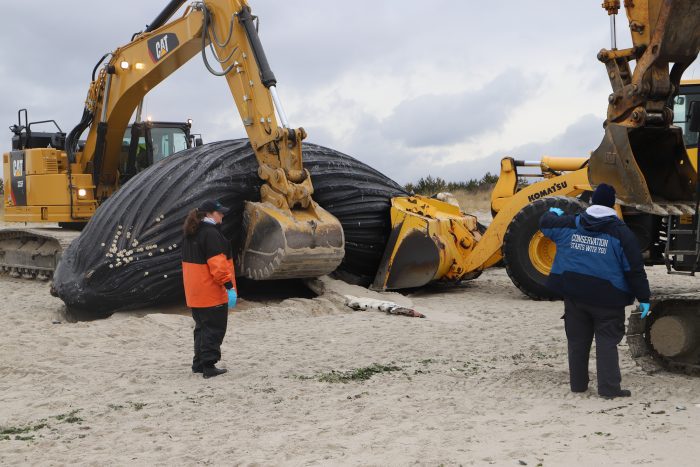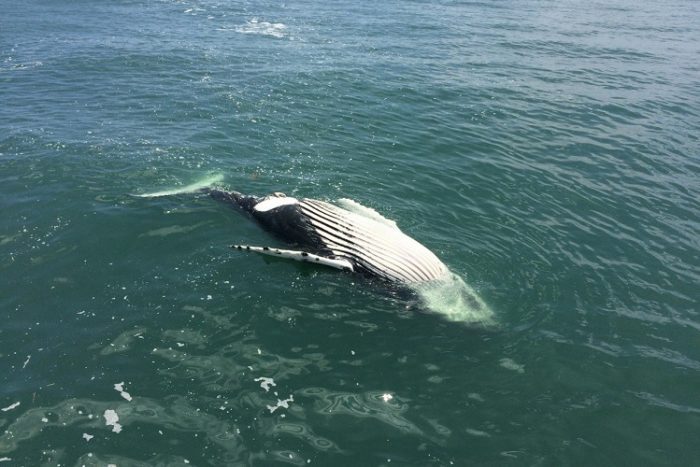Since 2016, various agencies along the Eastern Seaboard have been investigating unusual mortality events among whales, including humpback, minke and North Atlantic right whales.
In recent months, a growing chorus of politicians, pundits and some environmental groups have suggested that efforts to build wind farms in the water and, specifically, to use sonar to develop a contour of the ocean floor, may be confusing whales, injuring their ears or causing these marine mammals to lose their way.
Research groups such as the Atlantic Marine Conservation Society have raced to the scenes of these beachings, hoping to gather enough information to learn about the lives of these whales and conduct necropsies to determine a cause of death. [See story, “Humpback whale deaths increase along Eastern Seaboard,” TBR News Media website, Feb. 11.]
For many of these whales, however, the decaying condition of the carcass makes it difficult to draw a conclusive explanation. Additionally, some whales that weigh as much as 30,000 pounds have washed up in remote and protected places, making it difficult to analyze and remove them.
Robert DiGiovanni Jr., chief scientist at AMCS has responded to over 4,600 strandings of marine mammals and sea turtles and has tagged over 120 animals, according to the society’s website. Currently, he is serving as the principal investigator on aerial surveys in the mid-Atlantic region.“We don’t have any evidence to suggest” a connection between wind farms and whale deaths.
— Robert DiGiovanni Jr.
Pointing to data from the National Oceanographic and Atmospheric Administration, DiGiovanni suggested that many of the whale strandings relate to vessel strikes.
According to NOAA data, 181 humpback whale mortalities occurred between 2016 and early February of this year. Researchers were able to conduct necropsies on about half of those whales. Of those examined, about 40 percent had evidence of a ship strike or entanglement.
“We don’t have any evidence to suggest” a connection between wind farms and whale deaths, DiGiovanni said. “What we’re seeing is what we’ve been previously seeing.”
He urged a close examination of all the changes and factors that could affect the location and health of whales, “not just one source.”
The chief scientist advocates consistent and ongoing investment in research on a larger scale, which could aid in responding to ongoing concerns about whale mortality events.
Understanding where whales are located is critical to protecting them.
DiGiovanni pointed to street signs around schools and neighborhoods that urge drivers to slow down because there might be children running into the street or playing on lawns.
Similarly, research about the location and movement of marine mammals can enable policies that protect them while they’re around the shores of Long Island and, more broadly, the Eastern Seaboard.
Researchers need to get a “better understanding of where these animals are and how that changes from day to day, week to week and month to month,” DiGiovanni said.
In aerial surveys a few years ago in the first week of February, he saw one or two whales. Two weeks later, he saw 13 right whales.
“We need to get a better understanding of those changes to help manage that,” the chief scientist said.
Against the backdrop of ongoing unusual mortality events, DiGiovanni noted that whale deaths occurred consistently before and during the COVID-19 pandemic.
“We saw a difference in what was going on in the world, but we still had large whale occurrences,” he said. “Pulling all these pieces together is really important.”
The Atlantic Marine Conservation Society is working to develop incident command systems for marine mammal strandings with towns, fire departments, police and other authorities.
When DiGiovanni gets a call about a stranded whale, he can reach out to local partners, particularly in areas where these events have occurred in the past. Such rapid responses can ensure the safety of the crew and any bystanders on-site and can help bring needed equipment.
“What we do is very specialized,” DiGiovanni said. “Getting people to understand that and getting what’s needed is usually the first challenge.”
Members of the conservation society team sometimes work 12 or 14 days straight without a break, depending on the complexity of a stranding and the number of whales washing up on beaches.
“The people doing this work are extremely dedicated to what they’re trying to answer” about the life and death of marine mammals, he added. Some of them drive six hours to a site to bring their expertise to bear.
“The discovery part is why we do this — to answer questions that would otherwise go unnoticed,” DiGiovanni said.






